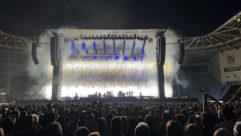NOT SO QUIET ON THE MONITOR FRONT
Oct 1, 2002 12:00 PM,
PETER H. PUTMAN, CTS
I’ve just finished a large review of 11 plasma and LCD monitors for sibling publicationVideo Systemsand have had some time to digest the results of all the tweaking, probing, and measuring that consumed the better part of three weeks.
In most cases, I wasn’t too surprised by the ongoing improvements to image quality, not to mention contrast, pixel scaling, and color fidelity. There’s just too much interest in plasma and LCD imaging to ignore those performance areas, particularly from fussy home-theater viewers and newly developing markets such as broadcast and post-production.
The quality of LCD monitors continues to improve at an amazing rate. The Sharp 30-inch wide-screen and Samsung 24-inch wide-screen models in this year’s review had image quality that was leaps and bounds over what was possible a year ago. If other issues such as white balance, black levels, and gray-scale tracking can be improved, active-matrix (AM) LCD monitors and TVs can and will pose a serious threat to flat-screen direct-view TVs and even small plasma monitors.
But plasma manufacturers aren’t sitting still when it comes to image enhancements. Several panels in this test flew by the 300:1 ANSI contrast mark, and two can produce black levels that rival a cathode-ray tube. Even so, there’s still the problem of false contouring to deal with, and it affects just about every manufacturer out there — not just with low levels of gray, but even high levels.
Video deinterlacing and image scaling is still an issue with most models. Outboard video scalers get cheaper by the month and work wonders with the majority of LCD and plasma monitors. Even a $200, 480p DVD player using Faroudja/Sage deinterlacing chip sets does better than most internal video processors.
However, a new kid on the block, LG/Zenith, sent me a 42-inch panel that did almost as good a job with deinterlacing and cleaning up video as Panasonic’s DVD-RP56, 480p DVD player, equipped with Faroudja electronics. In fact, this 42-inch panel was noticeably better at cleaning up interlacing scanning artifacts than some panels made by better-known companies, a couple of which are synonymous with video and broadcasting.
TRENDS
There’s still not much news on the longevity front. Plasma manufacturers seem to be obsessed with enhancing light output and contrast at the expense of good black levels, linear gray scales, and saving power. The truth is you just don’t need all those nits if you use a plasma monitor under controlled ambient lighting conditions.
For home theater, a panel needs to deliver only 85 to 100 nits (about 25 to 30 footlamberts [ft-L]), and it would be nice if low black levels fell into the 0.2-to-0.3-nits range (0.06 to 0.09 ft-L). Assuming false contours and gray-scale color tracking can be managed, you’ll see an image that is close to that of a direct-view CRT or rear-projection CRT set.
On the other hand, the public display market wants its screens bigger and brighter, hence the inflated 3,000:1 contrast ratio measurements seen in sales literature. No panel I’ve ever tested can hit that contrast specification (even in full-on, full-off modes) because it is a number usually taken with raw glass at the factory, before EMI shielding and antiglare glass is added.
Many of the panels I tested can pump out close to 300 nits (88 ft-L) with a small area white field, which is very CRT-like. Assuming the panels are simply installed and not calibrated for best gray scale — and the signal source is video and not static images — they may continue to churn along at this level of brightness for weeks and months before serious image burn-in is observed. But let a few signs, maps, or charts sit on the screen, and the panel could start burning in within hours.
The thin profile and big screens characteristic of plasma are what drive most buying decisions. As a result, prices continue to plummet on plasma. (Remember the rapid price declines for polysilicon front LCD projectors from 1995 to the present?) With the breaking of the $10,000 barrier for 50-inch glass at InfoComm 2002 by ViewSonic, Daewoo, and Optoma, other manufacturers are quickly following suit.
I was in the Wiz the other day (a regional consumer electronics store in the New York City area), which was advertising Panasonic’s PT-50PD3, 50-inch, 1,366-by-768 panel for $9,995 and the Panasonic 42-inch version for $4,995. About a week later, Fujitsu sent out a press release announcing its PDS-5004 product (50 inches, 1,366-by-768 pixels, DVI) for $9,999. How long before NEC, Sony, and Pioneer follow suit? (I predict they will have by the time you read this.)
Fujitsu also whacked the price of its 1,024-by-1,024, 42-inch product to $7,995, which will no doubt be copied by the rest of the high-resolution 42-inch products from Panasonic, Pioneer, and NEC. The rapid drop in the price of plasma is also shaking up other markets. Interest in liquid crystal on silicon (LCoS) imaging for rear-projection monitors and integrated TVs may be shifting because of this cost free fall.
RCA’s recent 2002 consumer line show did not feature its long-delayed 1,280-by-720, 50-inch LCoS Scenium TV, and rumors circulated that it had been discontinued. LCoS is not easy to manufacture (just ask JVC), and the delays in getting RCA’s $7,000 RPTV to market may have proven fatal.
Samsung’s introduction in June of a 50-inch DLP set with identical resolution for almost $3,000 less didn’t help, either. By InfoComm 2003, you’ll likely see 50-inch plasmas in the $7,000 to 8,000 (MSRP) range with 42-inch products falling to $3,500 or $4,000 and 32-inch plasma monitors and integrated TVs dropping even lower.
WHAT TO WATCH FOR
During the next year or two, keep an eye on the two sweet spots for plasma: 32-inch and 50-inch models. There is a lot of interest in those sizes for the consumer and pro A/V markets. The 32-inch size competes directly with 32-inch to 34-inch flat-screen monitors and integrated TVs, and 50-inch glass goes head-to-head with rear-projection TVs using both tubes and solid-state imagers such as LCDs and DMDs.
Right now a 32-inch to 34-inch direct-view 16:9 CRT TV can be had for $2,000 to 3,000, and that price is dropping. Thirty-inch LCD TVs cost about three times as much (as do plasma monitors), but that will all change quickly as flat-screen manufacturers such as Samsung, Sharp, Hitachi, and Sony, roll out more and more product to the masses. Panels measuring 42 to 46 inches will find more appeal in public display and specialized markets, and the 60-inch and larger sizes will be a low-demand item for some time to come.
In the pro A/V market, more competition from LCD and plasma manufacturer Samsung will further increase pricing pressures. Samsung is the largest manufacturer of AM-LCD glass and is jockeying with Sharp and LG-Philips. LG-Philips has also stated its desire to capture 15 percent of the U.S. TV and monitor market by 2005 and is bringing a full load of LCD and plasma products to the table at reduced prices.
Sharp and Matsushita have announced expansion plans to ramp up production of LCD and plasma. However, it’s not inconceivable that the plasma and LCD markets would wind up dominated by Taiwanese/Chinese and Korean manufacturers at the expense of the Japanese — that is, unless companies such as Matsushita, Sharp, NEC, and Hitachi decide to move a lot of their manufacturing offshore and reduce labor costs.
Shop aggressively for your installations and don’t be afraid to haggle over prices. There is excess manufacturing capacity for plasma, highlighted by Fujitsu-Hitachi’s recent decision to scale back its production plans from 60,000 panels a month to the present level of 30,000 panels. Don’t expect that number to go up significantly until sales at the consumer level take off — and that won’t happen until prices drop another few thousand dollars.
Peter H. Putman owns PHP Communications, in Doylestown, Pennsylvania. The author ofThe Toastmasters Guide to Audio/Visual Presentations,Putman is also a regular columnist inS&VC.










